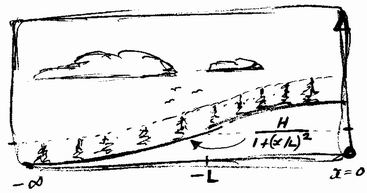
University of Alberta
Atmosphere Modelling, EAS 471
Jan.-Apr., 2014
Topics and Tentative Order of their Coverage
For some of you, one or more topics may already be familiar, in which case please consider coverage here to be a review. The timing (ordering) of material may seem slightly unnatural, but is designed to get us going on manageable and (hopefully) interesting computing assignments as quickly as possible.
The course outline states our coverage as being: "Dynamics and physics of general circulation models. Numerical Weather Prediction models, ocean models, limited area models. Finite difference methods; spectral methods, and numerical stability." (That broad range is intended to accommodate the specialities of the range of instructors who deliver the course, and content varies from year to year and instructor to instructor).
Logical Breakdnown of Topics
- Understanding the equations of motion from first principles
- Averaging the equations of motion to obtain equations for the "resolved" flow, and the resulting closure problem
- Formalities of numerical method for solving the equations typical of flow problems, e.g. origin of numerical errors, numerical stability, etc.
- Simplified (idealized) flow problems: linear and non-linear advection equations; diffusion (heat) equation in one or more dimensions; simultaneous advection and diffusion (in some cases we may be able to compare numerical solutions with analytical solutions)
- Review of Canada's Global Multiscale Environmental (GEM) NWP model from perspective of the above
- Simulating transport in a given (known) flow: examples of Eulerian and Lagrangian methods. (Examples will be relevant to air pollution models)
- Time permitting, we may explore
- esoteric methods to solve flow equations, so-called "spectral" or "Galerkin" methods - this takes us a little into the domain of applied maths
- "parameterization schemes" for the representation of one or more "unresolved processes" in numerical weather or climate models (e.g. cumulus parameterization; representation of boundary layer turbulence)
Tentative Order of Covering Material
- Simplest numerical Lagrangian model for turbulent dispersion (sometimes called turbulent diffusion) in a "known" flow: the drunkard's walk [optional general and advanced reading]
- what is meant by "known" flow. Reynolds averaging to distinguish "resolved" (mean) and "unresolved" (turbulent) components of a flow field
- review of salient statistics pertinent to description of unresolved flow. Exemplification: mean flow and turbulent velocity statistics characterising the stratified atmospheric surface layer, and the Monin-Obukhov similarity theory (motivated by our pending computing assignments on atmospheric dispersion)
- programming the drunkard's walk model - Lab exercise 1
- comparison of numerical solution (in near and far fields of source) with Taylor's Lagrangian theory
- Numerical methods in fluid mechanics
- Eulerian Derivation of a Generalized Conservation Equation; familiarization with operators (grad, Laplacian); Lagrangian (Material) Derivative
- Discretization. Explicit and implicit schemes. Classification of equations and of numerical errors. Lax equivalence theorem. Algorithms for numerical solution of paradigm problems (linear advection; heat equation). Numerical stability analysis. Aliasing and non-linear computational instability
- "Relaxation" method for solving elliptic partial differential equations. Lab exercise 2 (solving a heat equation).
- Algorithm for the advection-diffusion equation - Scored Lab assignment 1 (applying this algorithm to dispersion from a gas source in the atmospheric surface layer)
- Higher fidelity Lagrangian treatment of atmospheric dispersion
- Generalized Langevin model and the equivalent Fokker-Planck equation. The well-mixed constraint. Well-mixed Langevin model for dispersion in the stratified atmospheric surface layer. Scored Lab assignment 2 (applying this algorithm to Project Prairie Grass dispersion experiments)
- Galerkin (Spectral) method applied to non-linear advection equation
- Canada's GEM model for NWP
- GEM's "parameterization schemes" for the representation of one or more "unresolved processes" in numerical weather or climate models (e.g. cumulus parameterization; representation of boundary layer turbulence)
Back to the EAS 471 home page.
Back to the Earth & Atmospheric Sciences home page.
Last Modified: 7 Jan., 2014
